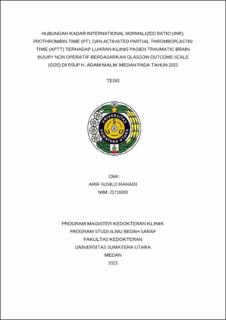| dc.contributor.advisor | Sabri | |
| dc.contributor.advisor | Arsyad, Abdurrahman Mousa | |
| dc.contributor.author | Rahadi, Arif Susilo | |
| dc.date.accessioned | 2025-01-21T05:01:02Z | |
| dc.date.available | 2025-01-21T05:01:02Z | |
| dc.date.issued | 2023 | |
| dc.identifier.uri | https://repositori.usu.ac.id/handle/123456789/100403 | |
| dc.description.abstract | Background. Traumatic Brain Injury (TBI) is considered the leading cause of death and disability in individuals under 45 years of age. INR, PT, and aPTT are important for assessing bleeding risk in head injury patients. A common measure for long-term functional outcome in TBI patients is the GOS or its extended version the Glasgow Outcome Scale Extended (GOSE). Coagulation disorders may affect the outcome of TBI patients. Laboratory tests such as INR, PT, APTT, and PLT are used to predict bleeding risk and influence clinical outcomes. Aim. To determine the impact of INR, PT and aPTT disorders on the clinical outcomes of Non Operative Traumatic Brain Injury patients treated at RSHAM Medan from January-December 2023 based on the Glasgow Outcome Scale (GOS). Methods. This is a descriptive research with a cross sectional approach. The study was conducted by taking secondary data from patient medical records. Results. From 39 patients who met the criteria, the mean age+SD of the patients was 37.17+15.54. Male gender in this study was 80 people (76.9%) and female 24 people (23.1%). INR 1.12+0.14 seconds, PT 12.93+ 9.76 seconds, and aPTT 28.77+6.68 seconds were obtained. There was a statistically significant relationship between INR with GOS (p=0.045) and aPTT with GOS (p=0.035) but there was no relationship between PT with GOS (p=1.000). Discussion. Elevated INR in TBI patients may increase the risk of injury, especially bleeding. Most previous investigations into TBI-related coagulopathy have focused on PT or INR abnormalities. APTT is an indicator of intrinsic pathway activation time and is sensitive to specific coagulation factor deficiencies. Studies show a correlation between APTT and negative outcome or death of TBI patients. Conclusion. There is a relationship between International Normalized Ratio (INR) and activated Partial Thromboplastin Time (aPTT) levels, but there is no relationship between Prothrombin Time (PT) levels and clinical outcomes of Non Operative Traumatic Brain Injury patients based on the Glasgow Outcome Scale (GOS). | en_US |
| dc.language.iso | id | en_US |
| dc.publisher | Universitas Sumatera Utara | en_US |
| dc.subject | Traumatic Brain Injury | en_US |
| dc.subject | INR | en_US |
| dc.subject | PT | en_US |
| dc.subject | aPTT | en_US |
| dc.subject | GOSE | en_US |
| dc.title | Hubungan Kadar International Normalized Ratio (INR), Prothrombin Time (PT), dan Activated Partial Thromboplastin Time (APTT) terhadap Luaran Klinis Pasien Traumatic Brain Injury Non Operatif Berdasarkan Glasgow Outcome Scale (GOS) di RSUP H. Adam Malik Medan pada Tahun 2023 | en_US |
| dc.title.alternative | The Relationship Between International Normalized Ratio (INR), Prothrombin Time (PT), and Activated Partial Thromboplastin Time (APTT) Levels on Clinical Outcomes of Non-Operative Traumatic Brain Injury Patients Based on The Glasgow Outcome Scale (GOS) at RSUP H. Adam Malik Medan in 2023 | en_US |
| dc.type | Thesis | en_US |
| dc.identifier.nim | NIM21716003 | |
| dc.identifier.nidn | NIDN0005067313 | |
| dc.identifier.nidn | NIDN0002108601 | |
| dc.identifier.kodeprodi | KODEPRODI11729#Ilmu Bedah Syaraf | |
| dc.description.pages | 80 Pages | en_US |
| dc.description.type | Tesis Magister | en_US |
| dc.subject.sdgs | SDGs 3. Good Health And Well Being | en_US |


